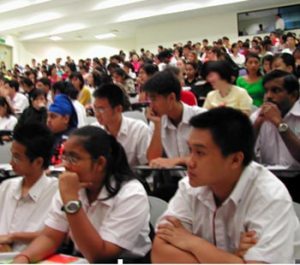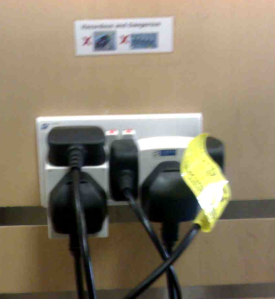Archive
Woe Cup 2010

By Ron Chua
Leon Lu could find himself missing out on the biggest sporting event of the year. He joins many other Singaporean football fans facing the bleak prospect of not being able to catch any World Cup action when it kicks off in South Africa this June.
209 countries have already secured the rights to broadcast the epic event that begins on Jun. 11, but Singapore is not one of them. With less than 70 days left to the opening match, football fans in Singapore will be left high and dry. Even though the football governing body, FIFA, has made the opening game, semi-finals and finals free-to-air, Singaporean fans are still less than cheered.
Lu and his fellow football fans are not the only ones affected. Businesses are also sweating over the impasse.
One of them is St. James Holdings that owns a number of bars in Singapore. Chief executive officer, Dennis Foo said, “(The World Cup) is once every four years and the climax of football. Without the live broadcasts, our business will be 50 per cent down but with it, we will be 50 per cent up.”
Advertising agencies are also feeling the pinch. With less than three months before the kick-off, analysts say advertising deals are getting harder to score. Victor Ng, chief creative officer at advertising agency Euro RSCG Singapore said, “Advertising campaigns that capitalise on the World Cup are highly time-sensitive.”
Regardless, some companies are continuing with their publicity plans. A spokesman for Coca-Cola said, “It’s full steam ahead; we absolutely believe in it and we’re not shying away from promotions just because the airing might be limited.”
Many are unhappy with SingTel’s and StarHub’s failure to negotiate a deal with FIFA’s regional sales agent, Football Media Services. The deadlock began after SingTel had won the exclusive rights to broadcast the English Premier League for the next three seasons.
According to an industry source, FIFA is asking for close to $100 million in broadcasting rights for the upcoming World Cup. This is up from the $10 million and $15 million StarHub paid in 2002 and 2006 respectively to broadcast the same event.
The source said, “Last year, FIFA quoted a price to both telcos, which was already a few times more than what StarHub paid for the 2006 World Cup.”
“After SingTel won the EPL rights, FIFA came back with an even higher amount,” the source added.
Several reports quoted that SingTel won the English Premier League broadcasting rights with a bid of $400 million. However, SingTel Pay-TV vice-president, Tim Carmichael, has come out and clarified that their bid “was less than the quoted amount.”
With the clock ticking, fans like Lu are desperate in their frustration. The second year student at the Nanyang Technological University said, “This is ridiculous. Somalia, Ethopia and us do not have the broadcast rights.”
Similarly, full-time national serviceman Lionel Lin said, “We can afford the EPL for three seasons but we cannot afford one month of World Cup.”
But there are others who feel that the companies should not give in to their demands. The escalating price of watching sports on cable television has many Singaporeans pessimistic that the eventual costs will be passed on to consumers.
The question now is, how much are fans willing to pay to watch the World Cup’s 60 matches in June? From $8.40 a month in 2004, fans now pay $26.75 just for StarHub’s sports package.
Taxi driver, Peter Chua said, “I will not pay unreasonable amounts to watch the World Cup. I might as well go to JB and watch.”
53 year-old Linda See had similar sentiments. She said, “If we give in this time, they will come back with a higher price in 2014.”
Being able to catch the semi-finals and final is good enough for Lee Shirley, a fan of football legend Cristiano Ronaldo. The third year student from the Singapore Management University said, “It will be best if Portugal wins the World Cup.”
Still, sports buff Cris Tan believes that SingTel or StarHub should secure the rights at all costs. The 27-year-old public relations practitioner said, “It comes only once in four years. I cannot wait eight years to watch the next World Cup.
For football-crazy Singapore fans, it is not over till the final whistle blows. “I might just install an antenna and tap into signals from Malaysia or Indonesia,” Tan added.
Owe Money Pay Money
By Clara Huang
He has a house he does not dare return to. For the past few weeks, the door of his flat in Tampines has been splashed with paint and locked with a steel chain. Samuel, who asked to be identified only by his first name, had chalked up huge debts after taking out a loan for his new business venture.
“My business is doing badly and I can’t repay. Then the boys wrecked havoc right away,” he said, referring to the loansharks who caused his family to seek refuge at a relative’s house.
Despite the relatively low crime rate in Singapore, the city-state has been plagued by a surge in loanshark-related violence in public housing estates. According to Ng Boon Gay, director with the Criminal Investigation Department, said that there was a 58 per cent increase from the previous year. There about 18,600 cases of illegal loans made by loansharks in 2009 alone.
According to the Singapore Police Force, one in five of those arrested for loan sharking and intimidation last year was aged 19 or under, compared with just one in 10 in the first half of 2008.
Loansharks lend money at exorbitant interest rates to those whose credit ratings are too poor to borrow from banks, drawing them with the promise of quick cash and fast approval rates.
These unlicensed money lenders then recruit runners to assist them in harassing the debtors who default on repayment. While some of the runners are lured to these nefarious activities to earn easy money for deceptively simple work, others do so to pay off their debts.
Tan Wei Boon, a former debtor of the illicit loansharks who almost caused his family to break up, said, “They gave me an option to repay back.”
He also said they asked him “to join them to be their runner. But I refused because it’s illegal.”
In fact, some loansharks have even made innocent neighboring households the target of threats, hoping that the pressure would force the debtors to repay their debts.
34-year-old Lim Yi Qi is among the residents who are upset that the peace of her neighborhood is disrupted.
“They broke my flower pots outside my house. My family and I are innocent and I’m really worried for my family’s safety, especially my daughter,” Lim said.
“Police should also hold borrowers accountable as their reckless borrowing and gambling habits endanger our community,” Lim added, expressing her displeasure towards irresponsible gambling addicts who have sought out loansharks to clear their debts.
While some of the borrowers are gambling addicts, government officials empathize with those who are faced with unplanned or short-term financial squeeze. At the Ministry of Home Affairs, officials announced in January that it is a criminal offence for errant debtors to borrow from unlicensed moneylenders.
Nevertheless, it is not possible to fully anticipate what new tactics the loansharks will adopt. In fact, loansharking and related harassment look set to become a greater threat to the citizens’ safety, as the Internet will allow them to perpetrate their crimes under the shroud of anonymity.
“I was told to transfer money electronically to them. Nowadays they’re more efficient than I thought,” said Samuel, recalling the first time the loan was made.
Law enforcement officers are doing their best to detect and punish all those who are involved in loansharking. The Ministry of Home Affairs is confident that the loanshark scourge can be tackled efficiently with the implementation of the new Moneylenders (Amendment) Bill in January this year.
The ministry will toughen the penalties for those carrying out loan sharking as well as those who assist the gangs. Still, unlicensed moneylending and loanshark harassment cases are not easy to solve, as there is still demand for them.
Frustrated by the thorny episode, Samuel urged people to understand the ramifications of borrowing from loansharks in spite of the easy way out.
“They should keep in mind that owing loanshark money not only causes mental and emotional strain to them, but also affect their family and loved ones as well,” he said.
Sharing the same sentiments, Tan regretted his decision to borrow from loansharks as he recounted on the turning point in his life although he has repaid his debts two months ago.
“The state should do more to help those in need of temporary financial assistance, such as slacken the bank loan policies for people like us to tight over this temporary financial burden,” Tan said.
Students Hard at Work
By Gloria Lee
Singapore Polytechnic student Kevin Tan, 22, finishes school before 3p.m., but gets home in the wee hours every day. As a result, he finds it hard to wake up in time for early morning lessons.
A freelance sound technician in charge of setting up sound systems for concerts and functions, Tan usually ends work after 2a.m. He is often misunderstood by his tutors who think he is out gallivanting. It is surprising that they do not show more understanding when he explains his situation.
“My teachers always haul me over the coals when my grades drop, blaming it on my work even though it’s not the case. Some even asked me to apply for financial aid so that I can stop working. But I like my job, and this is the industry that I eventually want to settle down in,” said Tan.
Initially, his mother was not supportive of the idea of him working while studying. But she came to accept it after she observed how he became more streetwise and responsible since working.
This is a scenario that many tertiary students will find familiar. It is common belief that students work because of financial problems. However, some students work during their vacation or even during term time for extra money to spend or to plump up their resume for enhanced employment prospects.
This rising phenomenon is boosted by the adoption of flexible work schemes by employers that are “especially suitable for students or adults pursuing further study”, as retired NTUC Income chief executive officer Tan Kin Lian noted on his blog.
Educators however appear divided over this new trend.
“If their families don’t need the extra money, they should not work part-time because it takes up their time and energy. School life is already busy and stressful enough without that extra load,” said Geraint Wong, a teacher at the School of Science and Technology.
Andrew Ng, programme executive for student life and services at the Singapore Institute of Management, disagrees.
“Many SIM students juggle work and studies. I think it’s good training because it will be something they have to do when they start work soon. It teaches them to manage their priorities well,” Ng said.
In a speech to Parliament last month, Senior Parliamentary Secretary for Manpower and Health, Hawazi Daipi, reiterated the government’s support of flexible workplaces. He noted that “employers in Singapore increasingly recognize the value of flexible work arrangements in attracting and retaining employees.”
Victor Lee, managing director for Vohringer Singapore, agrees. “Our corporate policy is not to hire part-timers. However, we have been looking at hiring students for freelance jobs, because it complements the skill sets of our permanent workers,” Lee said.
According to the Ministry of Manpower’s Employment Act, those who work fewer than 35 hours a week are considered part-time workers. Some students are coping so well that they even take it a step higher by entering the workforce proper.
This trend seems set to continue, as work and study programmes such as the National University of Singapore Overseas Colleges are gaining popularity with tertiary students, with a record sign up in its recruitment this year.
Starbucks store manager, Joan Lim, 24, has been with the café since she was 16. At the time, she was a full-time student working part-time. When she proceeded for further studies, she decided to switch to full-time work and part-time studies. The Tourism Institute of Australia graduate believes her decision has molded her into a stronger person, even as she admits it was not an easy path.
“You need determination and perseverance every step of the way, along with the ability to prioritize. You also have to forego your social life. But I have grown so much that if I had to choose again, I know I would do the same thing,” Lim said.
The economy today is a very challenging one, and it is not surprising that some students are proactively looking for part-time jobs because of post-graduation career concerns. It is not easy, but a good way to get ahead.
Benjamin Ng, 24, certainly thinks so. A full-time sales executive with a construction firm, he is enrolled in a part-time degree course in Murdoch University. Ng said, “This is the best way in which you can gain working experience as well as paper qualifications at the same time, while getting a pay check every month.”
This trend seems set to continue, as work and study programmes such as the National University of Singapore Overseas Colleges are gaining popularity with tertiary students, with a record sign up in its recruitment drive this year.
21-year-old Evelyn Lim, an undergraduate from that National University of Singapore School of Business, is among those who have successfully applied for the programme.
“I chose to come to [the National University of Singapore] mainly because I wanted to take part in this programme. I am sure it will broaden my horizons and make me more successful in my future career,” she said.
Power to the People
By Nadya Huang
There is no doubt that there are many power-hungry students in the National University of Singapore. Ang Zhi Wei, a 23-year-old political science major at the university, carries his multi-plug adapter to school every day so that he can pore over his work on the laptop. Yet, he finds it difficult to even secure a seat in the library next to a power socket.
It is a common sight to see students overloading power sockets in the library with extensions and multi-plug adapters. A quick check at the university’s Central Library on a typical Wednesday afternoon will attest to that.
Although the library has over 400 power sockets available for students to use, it seems that students still find there is a shortage.
“There are really not enough power points in the Central Library,” Ang said, “You either come real early or bring a multi-plug adaptor so you can get a seat beside a power socket to do work.”
Some students also use the power sockets to charge other gadgets such as their mobile phones. These habits contribute to the Central Library’s power bill of more than $96,000 a month. The management is aware of the situation, and has taken measures to cut down power consumption in other areas to offset the high electricity bills. However, there are problems impeding these solutions.
“We try to increase the temperature of the air-conditioning in the library but certain things like books and microfilms need to be kept at a lower temperature to maintain their condition,” said Patrick Lye, principal librarian of the university’s libraries.
“We are in an old building, and the electrical infrastructure might not be able to handle it,” he said, “but we are aware of the shortages and have contacted the Office of Estate Development to find a solution.”
Students are increasingly more dependent on their mobile gadgets. They spend long hours on their laptops trying to complete their work.
While some students are less conscious about their power usage, others have been actively trying to adopt good energy habits and encouraging others to do the same.
This group of students is from NUSSU Save, a student organisation devoted to fighting climate change. In conjunction with the World Earth Hour on March 27, they organized the Earth Hour event in the university.
During the event, students folded paper lilies out of waste paper as a symbol of hope for a better tomorrow. The 2668 paper lilies collected were used to create a tree-shaped mosaic at the Sports and Recreation Centre field. The display was lighted up with light sticks as a tribute to Mother Earth. This was recorded as the largest display of paper lilies in Singapore.
At 8.30pm on the day of the event, several non-essential lights on campus were turned off. The organizers had successfully managed to convince the administration to turn off more lights this year compared to last year’s Earth Hour.
These included lights from the various faculty buildings, six halls of residences as well as facility buildings in University Hall, Yusof Ishak House and the Sports and Recreation Centre.
23-year-old Calvin Tan is the Chairperson of NUSSU Save. The second-year Life Sciences student acknowledged that Earth Hour was more of a publicity event to raise awareness.
“The event itself does not do much for the environment, but is more of a symbolic gesture directed at individuals. We did get more than 2,000 different individuals to fold paper lilies and that is 2,000 people who can help to spread the message,” said Tan.
And they are not alone in their bid to save power and cut down consumption. The university’s Office of Estate and Development and Office of Environmental Sustainability work together in several projects to reduce electrical consumption.
These projects include the replacement of conventional lamps with energy-saving lights and installation of infra-motion sensors in newly renovated toilets. The office also intends to monitor trends in excessive electrical usage on campus so that they can implement measures to prevent wastage.
With so many initiatives to cut down on energy usage, there is definitely power to the people.



